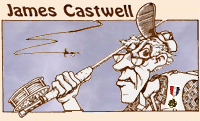|
From the very first time we go fishing there seems to be one way to get the bait out to the
fish. Swing the rod behind us and swing it forward. With that starts one of the hardest habits
to break for us fly-casters. With a casting rod or spinning rod it's always the same move.
If the lure is light, a sharp snap of the wrist back and forward gets the job done. Using a
heavy lure, more of a lob to the rear and a lob/swing to the front and out it goes. The action
is immediate, there is no reason for any pause while the lure goes back. That's the way you
learned to fish and cast. Another factor enters too.
The faster you get the lure out in front, the sooner you can catch a fish. I think that drive is
there for all of us, not dependant upon how you learned to cast. Both of these drives are a
detriment to fly-casting and here's why.
By now you know you must wait for the fly line to unroll behind you before you can make a
decent forward cast, period. If you are not that far into casting, you need to go back and read
some of the earlier columns on here. With that said, let me point out the major flaw in most
casting. Chances are, you, yes, you do it. The good news is, you can stop it. Why should
you stop doing it and change? How about making your casting much less work and casting
ten to twenty percent farther?
I have written before that it is hard to spot a casting problem without having a name for it.
Let's do it now. It is called drift, actually 'negative drift.' When you have made the back
cast and are pausing while the fly line unrolls behind you, you start to 'ease' the rod forward
as you are waiting. You may creep it to almost vertical, nearly straight up.
That's negative drift. Moving the rod forward too soon during the cast. It only allows you
the tip to use for the forward cast. Had you kept the rod exactly where you had stopped it
on the back cast, you would have had far more of it to use for the forward cast. The lower
section would have been brought into play to load and unload.
This is probably the most common casting fault. Watch those on T.V. The next time you are
on a stream, look around, especially at those who may be having a problem with any distance.
It is rare to fine anyone who is really doing a dead-lock on the back cast. When instructing,
we call it Lock & Load. By freezing the rod at the back stop you allow it bend
and unbend on the forward cast. Try it the next chance you have. I do see it sometimes,
but usually only on the very top casters.
The negative drift is not as much of a factor for those of you who only cast very short
distances, often with light rods and tiny flies. That type of cast is often just a flick of the
wrist and hardly any time is needed for the line to go back and return. Often the rod is
stopped high and the cast is directed close in front of you. Even while fishing this way it
can become a matter of needing a longer cast to a rising fish. The back cast is lowered,
the front cast is aimed and stopped higher and the old 'negative drift' comes into play
once more. It is no respecter of rod weights or line sizes.
Remember, your back-cast is a forward cast; only you are facing the wrong way. I doubt
if you would make a forward cast and as the line is rolling out, pull back on the rod. Quit
doing the same thing on your back-cast. Fly-casting for you will become less work, more
fun, give you greater distance when needed, but be aware, you may be mistaken for a 'Pro.' ~ JC
|





